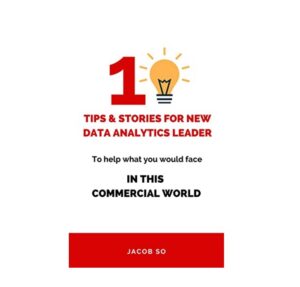10 Tips and Stories for New Data Analytics Leader: Practical tips and real stories which analytics leaders would face in this commercial world
What are you likely to face as a new Analytics Leader?
What should you consider before joining a company as their Head of Analytics?
What are the expectations from your key stakeholders?
“10 Tips for New Data Analytics Leader” is a guide that offers practical advice for individuals who are starting out as data analytics leaders. Whether you are a newly appointed manager, a team lead or a seasoned analyst transitioning into a leadership role, this eBook provides you with essential tips and strategies that will help you succeed.
In his book the author Jacob So covers a range of topics
Technical, Organisation Structure, Choice of Technology stack and much more
Here is one of the chapters to give you a flavour of the content
It is about segmenting a portion of your time to simply look for unknown insights in your data
Chapter 8 Reserve 1/6 of your resources on exploration (Explore the unknown)
As a company’s HA, you are likely to be overwhelmed with multiple tasks every day, from scheduled analytics and reporting tasks, and ad-hoc data support, to report and BI maintenance. At the same time, you may also be responsible for maintaining the data pipeline, ensuring data is of high quality, as well as planning the data architecture. Not to mention, you also need to maintain your team’s performance, training, and development. Given the above situation, it’s very common for new analytics leaders to always be firefighting, delivering analytics solutions within the agreed timeline while fine-tuning and optimizing them, leaving limited time for data exploration for unknown insights.
My experience tells me that more than 80% of analytics requests that come from business stakeholders usually have a clear objective or set hypotheses already. This type of request helps businesses answer key questions or optimize routine operations for different stakeholders. However, a HA should also think about delivering additional insights that are new to the business, as the business may not know what they do not know. This type of analysis may potentially help them avoid risks, may inspire their current work, and create different ways of thinking.
Setting aside roughly 1/6 of your time would mean 2 months in a year, which would be a sufficient timeslot for a thorough data exploration project. This is an achievable timeline, considering the HA has many other day-to-day projects to follow. Some of my peers may like to do it as a sharing session every 2 months as a smaller project in giving out some fun facts about the business, and some may choose to share something more robust in 6 months’ time with complete analytics for a specific function or area.
The difficulty of this type of analysis usually lies in how we start the project since there is no scope and direction. I would tend to start by chatting with individual function heads to understand if there are any current challenges that are unmet and if they do not have many ideas for tackling them. This may help generate different ideas in searching for some related data to look at in starting the data exploration project.
Story behind the tips
The Head of Analytics in a gambling company has committed to hosting a data-sharing session for all key stakeholders every two months, as it helps to build a data-driven culture within the company and enables business stakeholders to use data to streamline their daily job going forward. One of the topics he tasked his team to look at is understanding the exact pattern of customers who win big money from a slot machine and how they withdraw their money, as understanding the details may help the business to fine-tune the game or prompt different communications or promotions to encourage players to keep their money in the casino and continue betting instead of withdrawing.
While the team started to explore the data, they noticed something strange: they spotted some unusual activities that followed a set of patterns and led to the same result of withdrawing a significant amount of money from the company. The team then combined different data and investigated the matter in more detail, and found out that all of these customers were registered through prepaid phone cards and all of them were using the same zip code. Therefore, the HA believed this analysis may result in identifying some loophole inside the platform that members are taking advantage of, and this was quickly addressed to the chief risk officer as well as the game designer and product owner to understand the underlying issues and find a fix for it.
Eventually, this random analysis helped the company save a lot of money and helped the development team put more controls in place when developing new games to make them more secure in design. More importantly, it also shows how powerful data analytics can be and how it can make an impact on the business.
For more tips and stories for new data analytics leader, please check out his book in Amazon:
10 Tips and Stories for New Data Analytics Leader by Jacob So
https://www.amazon.co.uk/dp/B0BWHFRHJT
Having worked with Jacob for some time, we are happy to recommend his book, well worth a read with some interesting stories and examples
We support data leaders like Jacob with our bespoke consultancy services and mentoring as well as our Management Information Health Check
Find out about our Management Information Health check




